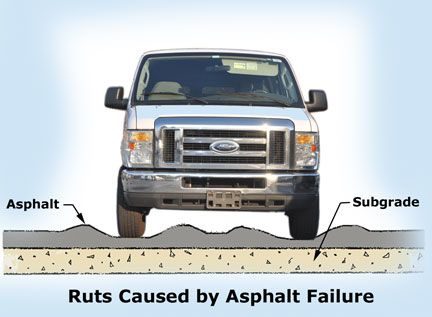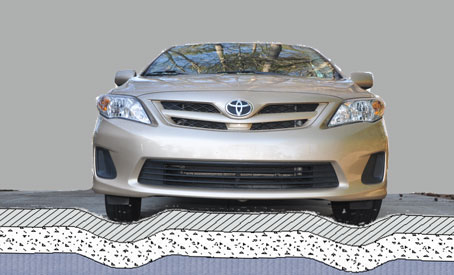For service in the Atlanta, Georgia area contact or call us:
Roadway Ruts Cause Hydroplaning
Ruts cause hydroplaning and before you can slow down, you feel your car move like it is on ice and you no longer have control of your car. You cannot steer or brake to slow down. Result...another traffic accident.

Ruts cause hydroplaning. Ruts are depressions or grooves worn into the road or path by the travel of wheels of vehicular traffic on the highway.
Heavy traffic on roadways creates ruts in asphalt pavement surfaces. Travel lane pavement supports thousands of vehicles in the same path every day, including heavy trucks. This repetitive loading of the pavement causes stress in asphalt and subgrade and in certain situations will cause the pavement to move and depress.
Ruts prevent water from flowing off the roadway. Ruts redirect storm water along the longitudinal path of travel. The water will stay in the rut until it overflows it. In the situation of a vertical grade, the water flows down the roadway increasing in depth as it flow downhill.

Water in Ruts can cause wheel drag
or vehicle hydroplaning
Another danger with ruts filled with water is tire drag. This is particularly dangerous when one tire path has no water and the other tire path is filled with water. The deeper the water, the greater the wheel drag. The vehicle will pull to the side which has the greater depth of water. The vehicle will be pulled toward oncoming traffic or to the ditch. Both can be a hazard.
What causes ruts in pavement? Highway pavement ruts are usually grouped into two basic types: asphalt mix rutting and subgrade rutting.
Asphalt mix rutting occurs when the design of the asphalt mix is such that the structural strength of the mix cannot support the volume of traffic and the weight of the vehicular traffic. This results from a design problem or a construction compaction problem. Here, the subgrade does not rut but the wheel path of the pavement surface depresses under the weight of the vehicles.
They created subgrade rutting when the subgrade depresses under the weight of the traffic and creates ruts in the wheel path of vehicular traffic. Here, the pavement settles into the subgrade causing surface depressions. Both types create depressions and the ruts cause hydroplaning.
Insufficient compaction of the asphalt layers during construction. If it is not compacted sufficiently, asphalt pavement could continue to compact under traffic loads.
Subgrade rutting is often the result of inadequate pavement structure. Improper mix design could be from excessively high asphalt content, excessive mineral filler or insufficient amount of angular aggregate particles.
Measuring the Depth of Ruts
Measuring the depth of ruts is very simple. It is simply using a straightedge and a steel measuring tape. Lay the straightedge across the roadway perpendicular to the direction of travel and measure from the bottom of the straightedge to the asphalt pavement.
Four commonly used methods
- Using a 10-foot straightedge.
- Survey of cross sections of the highway
- A Face Dipstick and
- Vehicle mounted laser equipment
Maintenance of Highways with Ruts
Ruts prevent storm water from flowing to the side of the road into ditches or gutters. Since storm water will get trapped in ruts and become a contributing factor to hydroplaning, it is important to inspect roadways which are prone to rutting.
Roadway workers employ several methods to repair roadways with ruts. They can fill ruts in asphalt pavement with asphalt. The pavement can then be over-laid with another layer of asphalt. Even better results are achieved by grinding the pavement surface. The crown and proper cross slope should be reestablished. Then pavement can be resurfaced.
If the ruts are formed due to deformation of the subgrade below the pavement, the only long-term repair is usually full-depth reconstruction of the road. The subgrade must be stabilized with engineered material before resurfacing.
Investigation to determine why the roadway pavement is Rutting
A heavily rutted pavement should be investigated to determine the cause of the pavement failure. Was the sub-grade and asphalt insufficiently compaction? Or is the rutting a result of low structural strength sub-grade or a poorly designed mix.
When a pavement shows ruts, highway maintenance personnel should monitor the rutting regularly. Should the rutting continue and the pavement ruts sufficient to redirect water, the pavement should be leveled and overlaid.
Ruts cause hydroplaning and hydroplaning is dangerous to all persons on the highway.
Need a Hydroplaning Expert?
Call Elvin Aycock, PE, PH, PLS. I am a licensed professional engineer, licensed professional surveyor, a professional hydrologist and I have reconstructed traffic accident. I have been a professional engineer for forty-five years.
Ruts cause hydroplaning. An analysis of the roadway surface will quickly determine if rutting is the problelm.
Related Information about Traffic Accident Reconstruction
|
Collision analysis in 10 steps The accident scene investigation Atlanta Engineering Services, Inc. offers scene mapping... read more here Learn how a vehicle black box and it's downloads can prove up evidence View a sample engineering report here Why you need an expert witness Calculating the stopping distance Multiple surfaces calculator to determine the stopping distance when there is more to consider. Vehicle speed calculator |
Accidents involving motorcycles How a vehicle inspection analysis can help you after an accident Reconstructing accidents involving Non-Commercial trucks Read how vehicle defects can be the cause of a traffic accident here. It just may be those roadway ruts that caused you to hydroplane, find out more here Was it poor design or layout that caused the accident? See real 3D accident simulations with this link More 3D accident reconstruction videos can be found here See actual photos of traffic accidents here |
G-ZNJ8QW23K9
